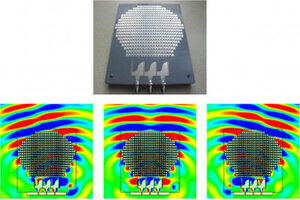Scientists make flat surface behave like spherical antenna
Scientists create an artificial surface that can bend and focus electromagnetic waves like an antenna

The prototype of the fabricated metasurface lens shown with simulated x components of electric fields at 9 GHz with the source placed at the bottom left, right and center of the lens.
T.J. Cui/Southeast University Nanjing
Researchers from China have created artificial surfaces that can bend and focus electromagnetic waves just like an antenna.
By arranging a large collection of tiny, metallic, U-shaped structures on the surface of a dielectric material, the team manufactured what they are calling "the first broadband transformation optics metasurface lens." The new lens has properties not found in nature.
The unique lens was engineered to mimic the properties of a Luneburg lens, a spherical lens first developed in the 1940s. Most lenses made up of single materials, such as plastic or glass, can uniformly bend light. The refractive index of a lens depends on what material it is made of. Glass, for example, has a refractive index higher than than of quartz. But in a Luneburg lens, the refractive index varies across its spherical surface, so the light bends depending on which part it hits.
Also, a typical Luneburg lens is unusual because it “can focus plane waves to a point at the edge of the lens, or radiate waves of the point source with high directivities, according to the findings of the study published in the journal of Applied Physics Letters on April 14, 2014.
Simply put, such a lens is capable of focusing light or electromagnetic waves to an “off-axis point at the edge of the lens." This means that the lens doesn’t directly focus light in front of it or behind it like a normal lens does. It can also direct electromagnetic waves coming from a nearby point source and radiate them in a particular direction.
Luneburg lenses have a wide range of applications as radar reflectors and as microwave antennae.
But the spherical nature of a Luneburg lens limits its use in other applications, Tie Jun Cui from Southeast University in Nanjing, China and an author on the paper said in a press release.
Therefore, the idea was to create a lens which would be flat yet it would have all the properties of a Luneburg lens.
"We now have three systematical designing methods to manipulate the surface waves with inhomogeneous metasurfaces, the geometric optics, holographic optics, and transformation optics," Dr. Cui said. "These technologies can be combined to exploit more complicated applications."

